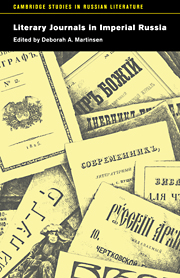Book contents
- Frontmatter
- Contents
- Notes on contributors
- Acknowledgements
- 1 Introduction
- PART I EIGHTEENTH CENTURY
- 2 The creation of journals and the profession of letters in the eighteenth century
- PART 2 EARLY NINETEENTH CENTURY
- PART 3 MID NINETEENTH CENTURY
- PART 4 SILVER AGE
- List of titles of journals and almanacs
- Select bibliography
- Index
- CAMBRIDGE STUDIES IN RUSSIAN LITERATURE
2 - The creation of journals and the profession of letters in the eighteenth century
Published online by Cambridge University Press: 11 March 2010
- Frontmatter
- Contents
- Notes on contributors
- Acknowledgements
- 1 Introduction
- PART I EIGHTEENTH CENTURY
- 2 The creation of journals and the profession of letters in the eighteenth century
- PART 2 EARLY NINETEENTH CENTURY
- PART 3 MID NINETEENTH CENTURY
- PART 4 SILVER AGE
- List of titles of journals and almanacs
- Select bibliography
- Index
- CAMBRIDGE STUDIES IN RUSSIAN LITERATURE
Summary
Most studies on the history of Russian journals concentrate, appropriately enough, on their intellectual and literary side: on ideas of the editors and authors, running debates among various publications, critiques of governmental policy, and the place of specific journals and journalists in educated society. At times, however, this focus on ideas and personalities is left floating in something of a sociological void insofar as it neglects the relation of a given journal – or of journalism overall – to the world outside these literary circles. This chapter addresses these issues: it is concerned with the institutional character of eighteenth-century Russia, and with the place of journalism as a specific medium in the development of lay educated society in the eighteenth century.
Journals, as printed publications coming out more or less regularly over a specific span of time, made their first appearance in Russia during the reign of Peter the Great. To be sure, the seventeenth century had produced a worthy ancestor to modern journalism in the informational periodical News and Notices (Vesti-kuranty). But News and Notices came out exclusively in manuscript, not in printed form; it therefore lacked the potential for the immediate and widespread circulation associated with printed periodicals. Moreover, it appeared episodically and unpredictably, and therefore, by definition, does not fit our understanding of a periodical.
The first true periodical publication, therefore, was the Petrine informational journal The News (Vedomosti), of which hundreds of issues were published between 1703 and 1727.
- Type
- Chapter
- Information
- Literary Journals in Imperial Russia , pp. 11 - 34Publisher: Cambridge University PressPrint publication year: 1998
- 35
- Cited by

